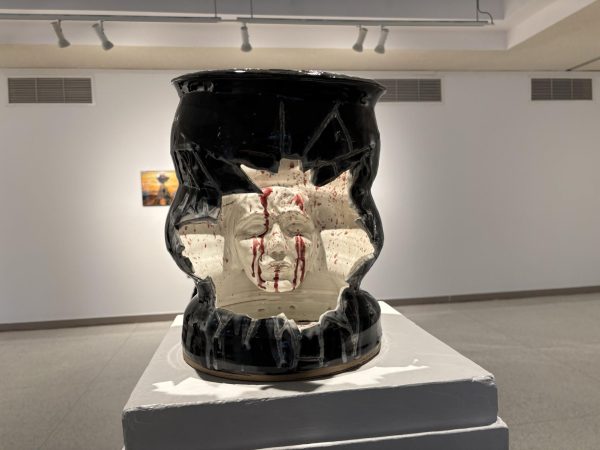Allegheny examines racial identity with new exhibition
Performing Blackness :: Performing Whiteness invites campus discussion
The Bowman Penelec Megahan Art Galleries of Allegheny College opened an exhibit called “Performing Blackness :: Performing Whiteness” with a reception on Tuesday, Jan. 20. Artists from around the world submitted their work to be a part of the exhibition.
Many of these artists have been featured in major museums worldwide including the Solomon R. Guggenheim Museum, the Andy Warhol Museum and the Musée d’art contemporain de Montréal. The art featured in the exhibition covers various mediums with pieces in the forms of text, audio, video, painting and installations .
.
During the reception, one of the featured artists, Alisha Wormsley, talked about her collection of works entitled “There Are Black People in the Future,” “Mantras” and “Extinction,” and the past, present and future of black culture. “There Are Black People in the Future” combined sound and resin objects the artist collected from people in the neighborhood she once lived in.
“It has to do with this idea of, at least what I’ve seen so far is this dissolving of African American identity or black identity into some sort of homogenize group,” said Rachel Simmons, ’16, an art major. “It’s trying to preserve and to say, showing that we have been here and black people have been here and our culture has been here. It is here and it will be here.”
Simmons spent her last semester working and studying in New York City. “There were tons of galleries everywhere. I really love being back in this kind of gallery setting,” said Simmons.
The art exhibition’s opening night brought in a diverse audience, including a number of students and professors from the College. John Christie-Searles, a professor of political science who also teaches black studies, had his students attend the opening reception. Combined with other reading materials required for the class, Christie-Searles hoped the exhibition would lead to discussions in class about black experience.
“But not just the black experience but how it fits into the context of the overall American experience and how whiteness plays part with in the black experience,” said Christie-Searles. “I think it’s always good to raise awareness, both of otherness and also similarities and in a lot of ways, we saw extinctions as not just a white phenomenon but also black phenomenon, especially within African American communities where there is violence and the white. ”
The exhibition also raised awareness of other minority groups. Jonathan Yee, ’17, an American-born Chinese student, worked as a gallery intern to help with the exhibition, mainly researching and conducting interviews with artists. Thinking about Allegheny’s Year of Voting Rights, Yee believed this exhibition provided “entry points” to have conversations about race on campus.
“I think this show is also about other minorities, how they are affected by binaries of black and white, how they are categorized into this binary,” said Yee.
“I feel like Asians get overlooked or we’re not talked about that much, since there are so many different cultures of Asia. We are all just put under this one big umbrella, which is just Asian, which sort of simplifies all of the people. Race is so much more complicated than that. ”
As the curator of this art exhibition, Darren Lee Miller, assistant professor of photography and gallery director, hoped the gallery would lead to discussions of culture, race and power.
“I think that I would be really happy and honored if the students coming to the exhibition would find that they were open to asking themselves questions, especially students who identifies as white, to ask themselves questions about what does it mean in America to be white,” said Miller. “That’s a question that before I started working on the show I never thought to ask myself. And I think that if we are going to think in a more sophisticated way about race, about difference, about privilege, then we have to start with that question.”
Miller has been working on this exhibition for nearly two years, it is only a coincidence that it is released during a time in America where race is a subject of great discussion and debate.
“I’m happy that the content is a timely conversation. Unfortunately, it’s tragic that this is a timely conversation,” said Miller. “I only hope that the works in the show, the interviews that we do with the artists, and the essay that I wrote to offer some context can be a point of reflection, can offer some place to start that conversation and so that we can have productive dialogue.”
The exhibition is free and open to public from Jan. 20 to Mar. 3.







